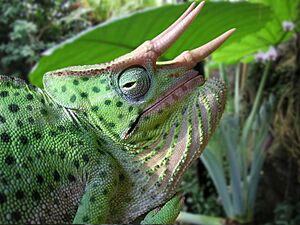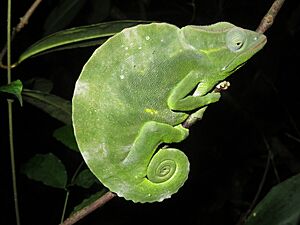Usambara three-horned chameleon facts for kids
Quick facts for kids Usambara three-horned chameleon |
|
|---|---|
 |
|
 |
|
| male above, female below | |
| Conservation status | |
| Scientific classification | |
| Genus: |
Trioceros
|
| Species: |
deremensis
|
| Synonyms | |
|
|
The Usambara three-horned chameleon (also known as Trioceros deremensis or the wavy chameleon) is a special type of chameleon. It lives only in the forests of the Eastern Arc Mountains in Tanzania, Africa. This means it is endemic to that area, found nowhere else in the world!
Contents
Where Does It Live?
This amazing chameleon lives in the mountains of Tanzania. You can find it high up, between 800 and 2,300 meters (about 2,600 to 7,500 feet) above sea level. Its home covers an area of about 1,400 square kilometers (about 540 square miles).
It mainly lives in the East Usambara, Uluguru, Nguu, Nguru, and Udzungwa Mountains. Each group of chameleons lives in its own separate area. They prefer forests, but sometimes they are seen in nearby hedges and even on farms.
What Does It Look Like?
The Usambara three-horned chameleon can grow quite long, up to 35 centimeters (about 14 inches) from its nose to the tip of its tail. Male chameleons are usually bigger than females.
Horns and Appearance
Male Usambara three-horned chameleons have three long horns on their heads. These horns likely help them in friendly fights with other males. Young males start growing their horns when they are about 10 to 12 centimeters long. Female chameleons do not have any horns.
These chameleons are usually green. They might have lighter or darker patterns on their skin. Sometimes, they can even show hints of yellow. If they get upset or scared, black spots can appear on their bodies, becoming very noticeable.
Life Cycle and Reproduction
The Usambara three-horned chameleon lays eggs. This means it is an oviparous species. Each mother can lay between 8 and 40 eggs at a time. When the baby chameleons hatch, they are very tiny, only about 5 to 7 centimeters (2 to 3 inches) long. They can even be a purplish-white color when they are first born!
Is It Safe?
The Usambara three-horned chameleon is quite common in the areas where it lives. The IUCN (International Union for Conservation of Nature) lists it as "Least Concern." This means it is not currently threatened with extinction.
Even though it lives in a small area, much of its home is protected in special reserves. Like most chameleons, it is listed under CITES. This means that if anyone wants to trade them internationally, they need a special permit.


